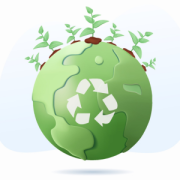AMPLIFY VOL. 36, NO. 10

Plastic dominates modern life. It offers extraordinary properties that ease industrial and everyday processes like packaging and transporting products, which helps reduce food waste. However, through mismanagement of plastics and plastic waste, plastic pollution is having negative effects on the environment, human health, and social justice.
Most of these negative impacts can be addressed by proper waste management infrastructures and the use of high-quality recycling technologies. The key challenges are not technical; they stem from a lack of investment due to insufficient market incentives, especially in emerging and developing countries.
This article focuses on the concept of plastic credits as a new financing mechanism for investment in circular plastic systems. Plastic credits are “a transferable unit representing a specific quantity of plastic pollution removed from the environment and/or put into the circular economy (i.e., collected and/or recycled) in excess of what would have happened in the absence of the credit-generating activity.”1
Plastic credit programs are getting a lot of attention and offer significant opportunities for financing circular plastic systems. However, uncoordinated and unregulated plastic credit programs carry risk, especially around incentives for waste prevention and the introduction of extended producer responsibility (EPR) systems — both are cornerstones in achieving sustainable plastic use.
This article discusses the conditions necessary to ensure that plastic credit programs lead to more circular systems (especially for plastic packaging) and do not undermine incentives for EPR systems, especially waste prevention. Our ideas are based on our empirical investigation of plastic credit systems in India.
Background: Idea & Concept of Plastic Credits
Plastic credit programs originate from climate change mitigation. Companies can offset their greenhouse gas emissions by buying carbon credits based on implementing certified measures that reduce CO2 emissions, such as industrial emission-reduction projects or reforestation.2 Many believe that carbon credits (with an estimated global market size of US $979 billion in 20223) lead to efficient climate protection because CO2 emissions should be reduced in places where mitigation costs are low. Often, this means emerging countries rather than countries that have already picked the “low-hanging fruit.” The argument for plastic credits is not as straightforward because specific environmental impacts depend on local circumstances. Nevertheless, they can make sense from an economic point of view.4
Because plastic credits promise a source of funding for underfinanced waste management in many parts of the world, several plastic credits programs have emerged over the last year, including a commercial one from rePurpose Global and nongovernmental organization–based programs from Zero Plastic Oceans and BVRio. They highlight the potential of such systems to increase collection and recovery/recycling of plastic waste in countries without sufficient waste management infrastructure while creating socioeconomic benefits by improving income opportunities for waste workers.
Organizations such as WWF5 and the Circulate Initiative6 have emphasized fundamental risks linked to plastic credit systems. Without clear definitions and standards, plastic credits could be used for greenwashing without any relevant positive impacts. Without sufficient transparency, governance-control mechanisms, and independent external verification of collected plastic waste, treatment processes, and treatment outcomes, fraud is also a risk. Companies voluntarily using plastic credits to offset their environmental impacts are not committed to long-term collection/recovery infrastructures, so there is also a risk that plastic credits can be misused by short-term activities or even one-off events.
Plastic Credits in Rural India
India suffers badly from environmental pollution but has great potential for improvement. Plastic waste pollution is prevalent in India’s rural regions, and a lack of financial support often hinders the collection and (environmentally friendly) end-of-life plastic processing.
In recognition of this, India´s 2016 plastic waste management rules have expanded to include rural areas, with responsibility for implementation handed to local administrations, also known as “gram panchayats.”7 Little improvement has been reported so far, mainly due to a lack of dedicated investments. To support these ambitions, the 2016 Plastic Waste Management Rules introduced an EPR program by the Ministry of Environment, Forest and Climate Change.8
Multiple amendments have been made to the regulations (in 2018, 2021, and 2022) but have thus far been unsuccessful in funneling sufficient finances toward waste management improvements. With the EPR implementation facing both short- and mid-term obstacles, particularly in rural areas, plastic credits may be the solution to improve traceability, accountability, and compliance while developing the necessary financial mechanisms.
Project Overview
A project called “Plastic Credits — Financing the Transition to the Global Circular Economy” aims to finance the implementation and improvement of a waste management structure in India’s rural regions, with pilot programs in Goa, Maharashtra, and Kerala. Insights into this project were gained through a site visit in September 2022 that allowed us to deepen our understanding of activities on ground by asking direct questions about existing waste-collection systems. In Goa, 25 kilotons of multilayer plastics (MLP) are generated per year; only 11% is collected. In Maharashtra, a value of 13 kilotons of MLP generation was estimated; so far, none has been collected.9
In rural India, informal waste pickers play a key role. For example, in Goa, informal waste pickers know the formal collection schedule and collect high-value materials and plastics in advance. The value of the collected plastic arriving at the materials-recovery facility is lower, but the financing structure via the municipality ensures this isn’t an issue for the local facility, and it gives collectors an incentive to ensure more accurate waste sorting.
At the end of the project-implementation phase, 379 workers in Kerala, 109 in Maharashtra, and 23 in Goa were involved in collection, preprocessing, and separation activities. Since women are employed almost exclusively for waste segregation, this results in a social benefit as well.
While discussions about an EPR program as a financing instrument of waste management activities are taking shape, the interrelation of such a framework with plastic credits remains unclear. India amended its EPR regulation in July 2022, mandating recycling and reusing of a certain percentage of plastic produced by manufacturers, importers, and brand owners.
During our site visit, city officials told us about the challenges they face in implementing EPR, saying there are issues with motivating companies to register under EPR and difficulties finding companies that purchase and recycle plastic under the EPR program.
Plastic Credits Should Not Undermine EPR
The links between plastic credit programs and EPR programs for packaging must be considered. EPR stresses the need for companies to take responsibility for end-of-life costs related to the packaging (and other products) they put on the market.10 This may include incentives around recyclability of products, use of recycled materials, and awareness-raising activities for needed waste-prevention solutions.11
There is ample evidence that EPR systems contribute to reducing packaging waste in the environment and enable financing of reliable waste management structures to ensure that waste is collected, sorted, and treated.12 Therefore, it’s important to ensure plastic credit programs don’t undermine or contradict current or future EPR systems. This can be done by avoiding:
-
Companies that buy plastic credits lobbying against the introduction of EPR systems as part of a country’s policy that would lead to mandatory fee-based payments (or physical obligations to collect and recycle their waste). EPR systems for packaging are more expensive for the obliged companies and, if mandatory, they cannot decide to pay less or not pay at all.
-
Cherry-picking of profitable types of waste as well as lowball pricing based on nonpayment for labor and lack of safety and health standards.13 Plastic credit systems, when coexisting in the same area, to some extent also compete for paying clients, which means they compete over price; this can lead to cherry-picking waste and/or lower worker-safety standards.
Crucial Requirements
Policymakers, companies, and consumers should work together to ensure plastic credit systems don’t conflict with the development of EPR systems or waste prevention. Experiences with carbon credits have shown the need for the following three items to be addressed by plastic credit systems before being purchased by private companies or public institutions:
-
Plastic credits should always be a last resort; prevention should be the priority. Plastic credits should only be sold to organizations that can prove they explored all available waste-prevention options. Companies communicating the amounts of plastic waste offset by plastic credits should always indicate the total amounts of plastic packaging put on the market, so the public can directly compare the negative and positive impacts of the company in question.
-
Plastic credit programs should commit to investing a share of their income into long-lasting infrastructures (as opposed to one-off cleanups) that can also benefit EPR programs. The longevity of these commitments should be publicly communicated.
-
Plastic credit systems should be a first step in the establishment of comprehensive EPR systems. Companies should reach out to all relevant stakeholders regarding data management and contractual arrangements, pursue credible monitoring of their activities, and actively participate in the development of harmonized criteria.
Outlook
In March 2022, the United Nations Environment Assembly (UNEP) adopted a historic resolution to develop an international legally binding instrument on plastic pollution.14 The need for innovative financing solutions was highlighted by many stakeholders, especially regarding countries or regions in which EPR systems have not yet been established. Plastic credits could play an important role here, but a transparent, credible governance system ensuring the quality criteria outlined above would be needed.
Further research is necessary to determine exactly how plastic credit programs can influence the quality of collection systems, the incentives for companies buying plastic credits to invest in waste prevention, and the coordination with EPR systems.
References
1 “Guidelines for Corporate Plastic Stewardship.” 3R Initiative/Earth Action (EA)/South Pole/Quantis, February 2021.
2 This understanding is based on: “WWF Position: Plastic Crediting and Plastic Neutrality.” WWF, January 2021. Nevertheless, it’s important to note that legal definitions are lacking, and the field of plastic credits is evolving quickly.
3 Daedal Research. “Global Carbon Credit Market: Analysis by Traded Value, Traded Volume, Segment, Project Category, Region, Size and Trends with Impact of COVID-19 and Forecast Up to 2028.” Research and Markets, April 2023.
4 “Plastic Credits — Friend or Foe?” ValuCred, July 2021.
5 WWF (see 2).
6 “A Sea of Plastics Claims and Credits: Steering Stakeholders Towards Impact.” The Circulate Initiative, January 2021.
7 “Notification: G.S.R 320(E).” Central Pollution Control Board (CPCB), India Ministry of Environment, Forest and Climate Change, 18 March 2016.
8 Proff, Silvia, et al. “Plastic Credits — Financing the Transition to the Global Circular Economy: Final Assessment Report on the Pilot Regions Goa, Maharashtra, and Kerala.” rePurpose/Wuppertal Institut, November 2022.
9 Proff et al. (see 8).
10 ”Resources EPR Toolbox.” Prevent Waste Alliance, accessed October 2023.
11 “Extended Producer Responsibility: Guidance for Efficient Waste Management.” Organisation for Economic Co-operation and Development (OECD), September 2016.
12 “Global Plastics Outlook: Economic Drivers, Environmental Impacts and Policy Options.” Organisation for Economic Co-operation and Development (OECD), 22 February 2022.
13 “Guidelines on Best Practices for Credit Systems Related to the Circular Economy.” Circular Credits Mechanism/BVRio/Circular Action Hub, September 2021.
14 “Intergovernmental Negotiating Committee on Plastic Pollution.” United Nations Environment Programme (UNEP), accessed October 2023.




